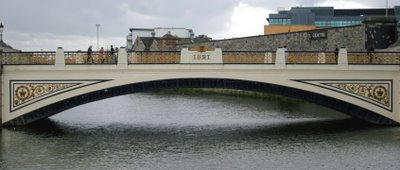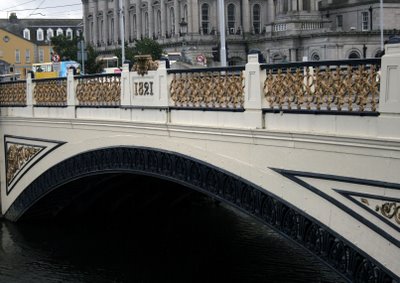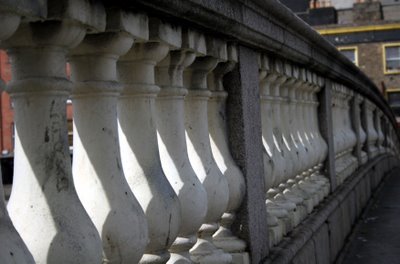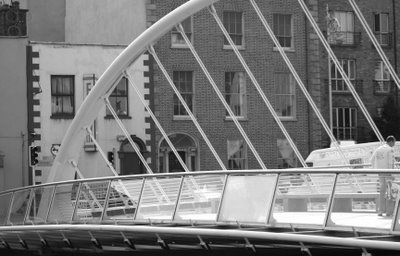through Dublin. There are roughly 11 bridges that cross over the
river, and I just think they're really cool for some reason. There's
something about them. I mean, obviously, they're necessary for
getting around town since the entire city is laid out on either side
of the river. But aside from their practicality, I think they're
charming. Each one different from the next. Some old. Some really
modern. Some decorative while others are strictly functional. I
thought they deserved their own post so you could see it and I
could remember them once we leave.
They're mostly in order; although, I've left out a couple like the
O'Connell Bridge which I've posted before and the very boring
Millennium Bridge. They are posted here as they appear in the city
going west to east, the same way the river flows.

Heuston Bridge is near the Heuston Train Station in Dublin, both of
which were named "in honour of Sean Heuston who was one of the
sixteen executed leaders of the Easter 1916 Rising," according to
www.irish-architecture.com. "The bridge is of iron construction
supported by two granite piers and was designed by George
Papworth who also designed several banks in Dublin," the same
site said.

A closer look at Heuston Bridge

Grattan Bridge, opened in 1874, is cast iron and is lit by ornate
lamps in the same material. There was a bridge here before
Grattan called Essex Bridge but it was partially washed away
by flooding and had to be replaced. Grattan Bridge was named
after Henry Grattan, a political force in Irish history during his
time.

Three bridges along the Liffey have a look very similar to this one.
So, I didn't photograph each of them. There is a close up look in
the next picture though.


This is the James Joyce Bridge, named after the writer himself,
"whose story The Dead is set in a house facing the bridge,"
according to www.irish-architecture.com. Cick here to see how
it looks when lit up in the evening. Following are two shots of
it from a closer vantage point.

The girl in this picture is a little dark, but she's wearing closed-toed
shoes, long pants, and a fleece jacket. I have a feeling it's a little
cooler here than it is in Arizona where we're headed soon.


Opened in 1859, Rory O'More Bridge is named after one of
the ringleaders of a plot to capture Dublin in October 1641.
The following three pictures were taken back in the spring...

The Ha'penney Bridge. Sometimes called the Symbol of Dublin,
it was originally constructed as a toll bridge in 1816. It's called
the Ha'Penney because you used to have to pay a half a penny
to cross it. Now, of course, you don't have to pay anything to use it.
The Ha'Penney is probably the most popular and famous of all
the bridges along the Liffey in Dublin. You can find a lot of little
paintings of it around town. It's a pedestrian-only walkway that
takes you from the north side of the keys right into the Temple Bar
district on the south side. It's very close to O'Connell Street Bridge
which is located at the middle of City Center. One of the city guide
books says it's "one of the oldest cast iron structures of it's kind in
the world."

The Sean O'Casey Bridge, named after the writer himself,
is a pedestrian-only bridge. Obviously a little newer than the
Ha'Penney, it is the third new bridge over the Liffey in the past
five years. It is in two sections which swing through 90 degrees
to allow boats to pass through. It's the last one between Dublin
and where the Liffey runs into the ocean.

This is the view from the Sean O'Casey Bridge, continuing down
the Liffey. You can see this is where the Liffey River ends and runs
into the Dublin Bay and then into the Irish Sea.
As Dublin has grown, the port has been moved further out.
What you see to the left and right of the river in the picture
above was the old port area. It's now an area of town called
the Docklands. They're doing a lot of development there -- the
up and coming area of town. Someone told me Colin Farrell has
a place down there.
And that's a wrap! See you next time.

No comments:
Post a Comment